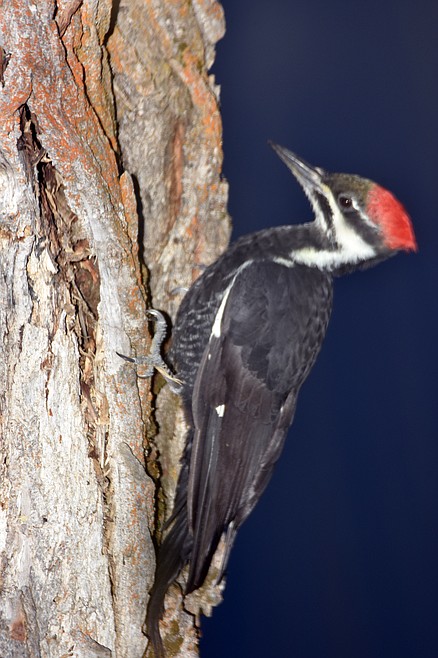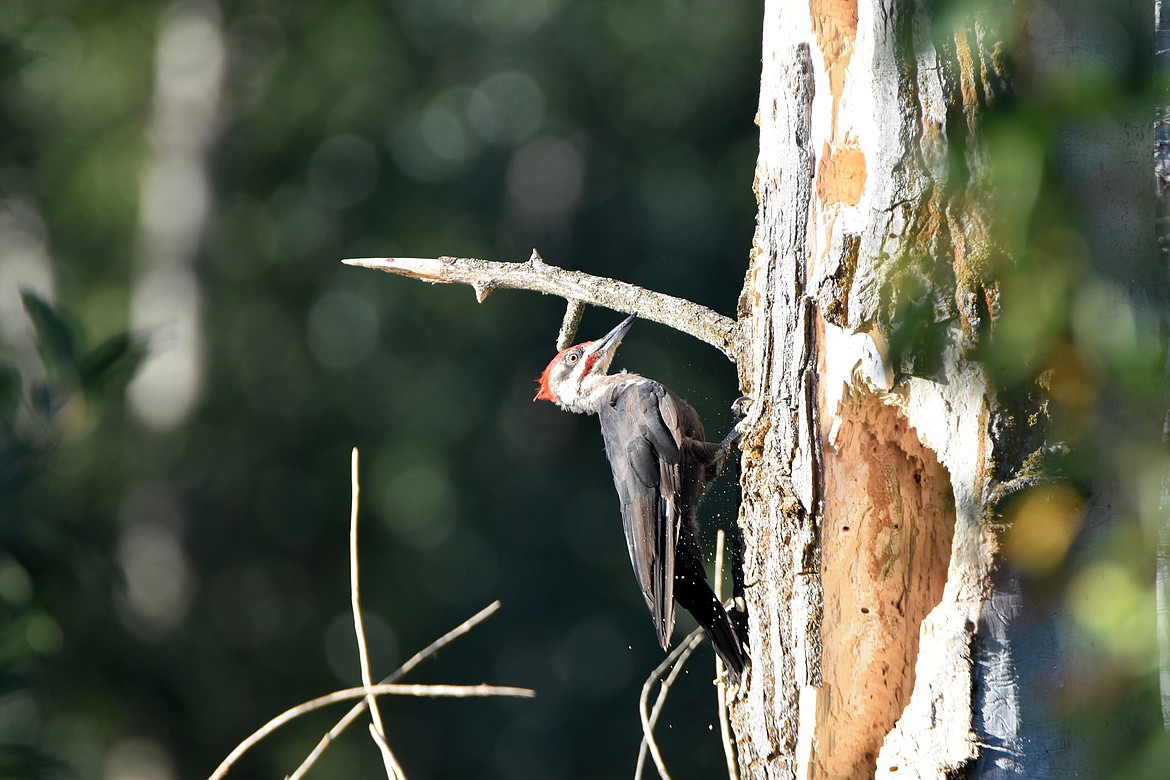Pileated woodpecker: Idaho’s largest woodpecker with a red cap
Find your own rhythm, peck away at obstacles, be colorful, carve out a place for yourself, make your voice heard, It’s ok to be a little flashy, use your head! … Advice from a Woodpecker
Recently I was walking down the Deep Creek Trail going east approaching the parking lot, when I heard a heavy drumming sound coming from a dead Black Cottonwood tree. Moments later I saw the red-crested forest ghost in a tree perhaps 100 feet from me through the bushy green leaves of a chokecherry tree that separated us. The distant rattling call resonated through the woods, silencing the constant chatter of a squirrel protesting the intruder. Another three second bust of loud tree whacking confirmed that a mate was near-by.
Welcome to the world of the Pileated Woodpecker, perhaps the most striking forest bird of Idaho. The Pileated Woodpecker is a year-round resident of Idaho and is easily and quickly recognized by its black body, white stripes down the neck and the most easily identifiable markings, its brilliant flame-red crest. No other bird boasts these markings, and the Pileated Woodpecker is indeed a very big woodpecker with up to a 30-inch wingspan. With a bit of practice, it is easy to tell the male from the female; the males have a noticeable patch of red feathers that run from the back of the bill across the cheek area to a point under the eye. It’s just a black patch of feathers in the same area for the females. Both the male and female are from 15 to 19 inches long.
The Pileated Woodpecker (Dryocopus pileatus) is one of the largest woodpecker species in North America and its look is unmistakable—a large black crow-sized bird with white on each side of its neck and a red crest on its head. When it flies, white flashes are visible under its wings.
The sound of the Pileated Woodpecker’s hammering carries a long distance through the woods where they live. They drum to attract mates and to establish the boundaries of their territory—warning other males away.
They use their beaks to pick and dig under bark to find carpenter ants, beetles’ larvae, and other insects and will often dig large, rectangular holes in trees to uncover their meals. Some holes are so big that they weaken small, young trees. The birds also strip pieces of bark from trees looking for food. Generally, however, Pileated Woodpeckers help keep a forest healthy by eating wood-boring insects.
Woodpeckers beat on trees for three main reasons: to forage for food, to excavate a nest cavity, and to drum for communication. The first two are relatively quiet affairs, done slowly and deliberately. The third is as loud as possible. Woodpeckers prefer the resonant acoustics of a hollow trunk or branch on which to drum—or a stove pipe or rain gutter—to make sure that their message gets across loud and clear. Both male and females drum.
Pileated woodpecker pairs mate for life and produce one summer brood. Courtship begins in early spring with head swinging, drumming, wing spreading displays, and crest raising. Both sexes help build a new nest cavity each year, typically in a dead or decaying tree. The opening averages 3.5 inches wide, though it can be larger, and may reach 24 inches deep. If you come across a relatively large, rectangular shaped opening in a decaying tree, with lots of fresh wood chips below it, you may have just stumbled upon a nest cavity.
A nesting pair of Pileated Woodpeckers usually makes a nesting hole in a large, older tree. During the day, both parents take turns incubating, or sitting on the eggs to keep them warm. At night only the male incubates the eggs. They generally lay four eggs at a time, which take about two weeks to hatch.
Have you ever wondered how woodpeckers avoid brain damage, striking at wood up to 12,000 times a day? The reason is, their sponge-like rear skull bones, along with a well-cushioned brain cavity and minimal cerebrospinal fluid (less sloshing around) help absorb the impact.
Enjoy Boundary County and the beautiful outdoors!



